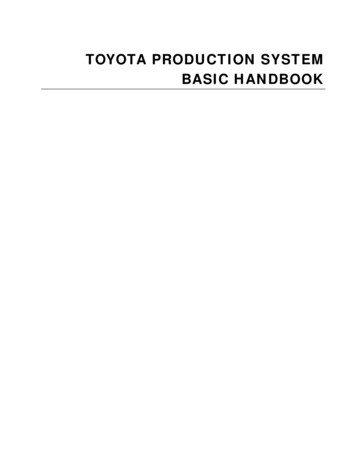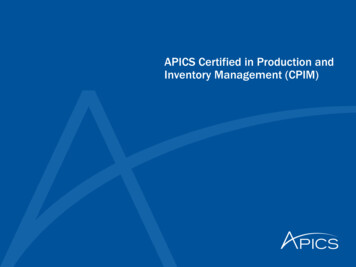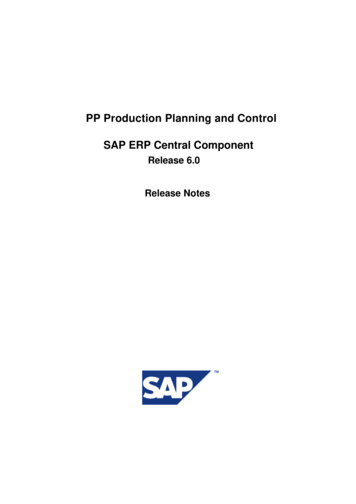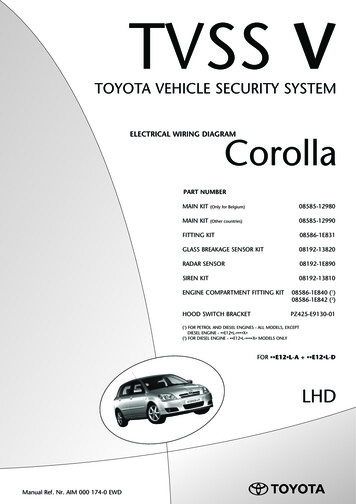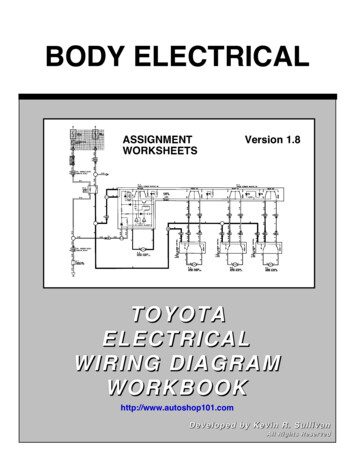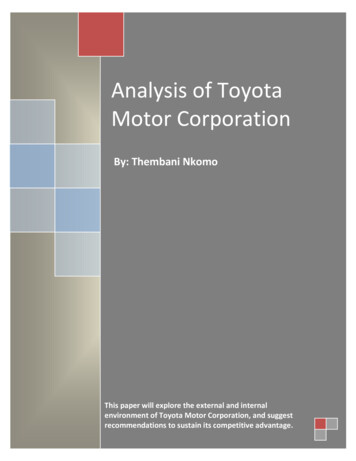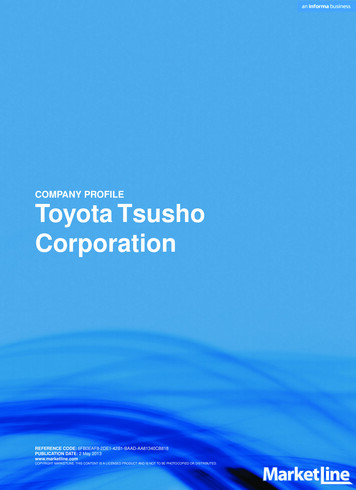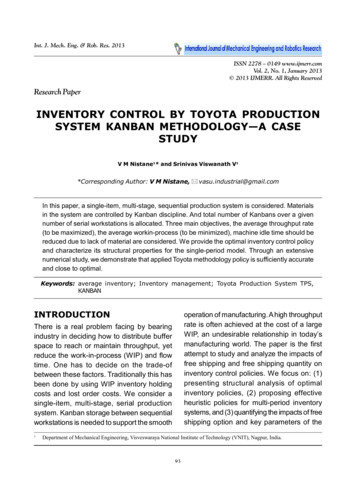
Transcription
Int. J. Mech. Eng. & Rob. Res. 2013V M Nistane and Srinivas Viswanath V, 2013ISSN 2278 – 0149 www.ijmerr.comVol. 2, No. 1, January 2013 2013 IJMERR. All Rights ReservedResearch PaperINVENTORY CONTROL BY TOYOTA PRODUCTIONSYSTEM KANBAN METHODOLOGY—A CASESTUDYV M Nistane1* and Srinivas Viswanath V1*Corresponding Author: V M Nistane, vasu.industrial@gmail.comIn this paper, a single-item, multi-stage, sequential production system is considered. Materialsin the system are controlled by Kanban discipline. And total number of Kanbans over a givennumber of serial workstations is allocated. Three main objectives, the average throughput rate(to be maximized), the average workin-process (to be minimized), machine idle time should bereduced due to lack of material are considered. We provide the optimal inventory control policyand characterize its structural properties for the single-period model. Through an extensivenumerical study, we demonstrate that applied Toyota methodology policy is sufficiently accurateand close to optimal.Keywords: average inventory; Inventory management; Toyota Production System TPS,KANBANINTRODUCTIONoperation of manufacturing. A high throughputrate is often achieved at the cost of a largeWIP, an undesirable relationship in today’smanufacturing world. The paper is the firstattempt to study and analyze the impacts offree shipping and free shipping quantity oninventory control policies. We focus on: (1)presenting structural analysis of optimalinventory policies, (2) proposing effectiveheuristic policies for multi-period inventorysystems, and (3) quantifying the impacts of freeshipping option and key parameters of theThere is a real problem facing by bearingindustry in deciding how to distribute bufferspace to reach or maintain throughput, yetreduce the work-in-process (WIP) and flowtime. One has to decide on the trade-ofbetween these factors. Traditionally this hasbeen done by using WIP inventory holdingcosts and lost order costs. We consider asingle-item, multi-stage, serial productionsystem. Kanban storage between sequentialworkstations is needed to support the smooth1Department of Mechanical Engineering, Visveswaraya National Institute of Technology (VNIT), Nagpur, India.93
Int. J. Mech. Eng. & Rob. Res. 2013V M Nistane and Srinivas Viswanath V, 2013model. W e conduct an extensivecomputational study and show that the heuristicpolicy is sufficiently accurate and it providesclose-to-optimal solutions A Industrial Engineermust assess both the benefits from throughputand the cost of average work-in-process andthe average flow time, before reaching anyconclusions about increasing the throughputrate. Clearly, managers must consider theintangible costs of WIP, in order to makedecisions that give a desirable balancebetween average throughput rate, averageWIP and machine idle time. These costsinclude an increase in flow time. Theobscuration of problems such as machinedowntime and excessive setup times by WIP;quality effects; and, costs due to lostthroughput such as lost orders if demand ishigh.desired components when they receive a cardand an empty container, which indicates thatmore parts are needed in production.LITERATURE REVIEW Avoids overproductionKanban, a technique for work and inventoryrelease, is a major component of Just-in-Time(JIT) and Lean Manufacturing philosophy.Kanban was originally developed at Toyota inthe1950’s as a way to manage material flowon the assembly line. Over the last threedecades, the Kanban process—a highlyefficient and effective factory productionsystem—has become a widely used tool in themanufacturing environment and globalcompetition. Minimizes wasteIn case of line interruptions, measures aretaken so that each workstation will only produceenough components to fill the container andthen stop. Kanban also limits the amount ofinventory in the process by acting as anauthorization to produce more inventories.Since Kanban is a chain process in whichorders flow from one process to another, theproduction or delivery of components is pulledthrough the production line, in contrast to thetraditional forecast-oriented method whereparts are pushed.Advantages of Kanban Processing Provides quick and precise information Provides quick response to changes Maintains full control Delegates responsibility to line workersThrough numerical studies, they show thatthe performance of the proposed Toyota policyis very close to that of the optimal policy and itsignificantly outperforms the policy undergeneral conditions. In this paper, we considera different and more complicated problemwhere the inventory system involves an orderquantity requirement, a fixed cost as well as abalanced inventory.Kanban stands for Kan- card, Ban- signal.The essence of the Kanban concept is that asupplier, The warehouse or the manufacturershould deliver components only when they areneeded so that there is no excess inventory.Within this system, workstations located alongproduction lines only produce or deliverPROBLEM IDENTIFICATIONThe problem of 10 to 15% rise in WIP inventoryfor JC 8037 Cylindrical type of Bearing wasreported by the higher-up of the company whichwas a starting point for the project. Therefore94
Int. J. Mech. Eng. & Rob. Res. 2013V M Nistane and Srinivas Viswanath V, 2013detailed study of the existing processes wasundertaken to quantify the exact rise of WIP,the cause and solution to remove thebottleneck. And moreover to control rawmaterials, bought out components andfinished goods of various bearings.discussed in the previous section, out of whichfollowing bearings have the more requirement.Study of Existing Process for theSelected BearingFor study of the process Bill of Material(BOM) is very important. The following Table 1shows the BOM for the above mentionedcomponents. JC 8037 JC 8038 JC 8033The company manufactures so many differenttypes and ranges of bearings which have beenTable 1: BOM for the Selected BearingsBearing DescriptionJC8037Component DescriptionComponent Qty6X12LP ROLERS-CRB1.000JC 8037 INNER RINGSCRB1.000JC8037 CRB MACHINED CAGESSTEEL (Drg. No. 3CA-196)JC8038JC8037 OUTER RINGSCRB14.0006X12LP ROLERS-CRB15.000JC8037 INNER RINGSCRB1.000JC8037 CRB MACHINED CAGESSTEEL (Drg. No. 3CA-196)JC8033JC8037 OUTER RINGSCRB1.0006X12LP ROLERS-CRB15.000JC8037 INNER RINGSCRB1.000JC8037 CRB MACHINED CAGESSTEEL (Drg. No. 3CA-196)JC8037 OUTER RINGSCRB1.000Above Figure 1 shows varies componentsfor the JC 8037. Outer ring, cage and needlesare the components for this type of bearing.Figure 1: Components of JC 8037/8038Type BearingCage and needles are produced in theinterplant and outer ring is manufactured inhouse. So for outer ring we need to giveoperation scheduling for which we must knowthe material flow.Block Diagram of ManufacturingProcess of CRB TypeMaterial flow diagram shows various workstations along with machines, efficiency of themachine, cycle time and change over time.Note: JC Jeau Circumferential (Gap between 1 st and LastNeedle).95
Int. J. Mech. Eng. & Rob. Res. 2013V M Nistane and Srinivas Viswanath V, 2013Figure 2: Material Flow Diagrams for the OUTER RING JC 8037Figure 3: PQ Analysis for the CRB BearingsWIP Was IncreasingFrom the collected data of month wise WIPinventory for the three types of selectedbearings as shown in the following Table 2 it isobserved that the WIP inventory is above thetargeted 6 days WIP inventory level as per thecompany standards.After study of the manufacturing linefollowing problems were observed. Increase in WIP inventory. Less utilization of available resources. Use of push system only.The purpose of this project work is thereforeto develop a mathematical model which givesoptimized scheduling for a bearingsmanufacturing, identify wastes and makerecommendations for improvement.As company was following 80/20 PQanalysis according to which 20% ofcomponents will contribute 80% of productionsuch as nearly 135 varieties of bearings for96
Int. J. Mech. Eng. & Rob. Res. 2013V M Nistane and Srinivas Viswanath V, 2013Table 2: WIP Inventory for Selected ComponentsMonth-Wise Inventory Days of WIP on Shop FloorMonthJC 8037 OuterJC 8037 InnerJC 18.648.82Figure 4: WIP Inventory for the JC 8037 Outer Ring in DaysFigure 5: WIP Inventory for the JC 8037 Inner Ring in Days97
Int. J. Mech. Eng. & Rob. Res. 2013V M Nistane and Srinivas Viswanath V, 2013Loss of Utilization of AvailableResources Because of the NoMeterial Conditioncylindrical roller bearings only 7 (seven)runners are there and remaining all varietiesare strangers. Here that is reason why we areconcentrating on Runner type components thatis JC8037/ JC 8038/JC 8038 B.Another problem faced by the companyis a loss of utilization of the machineFigure 6: WIP Inventory for the JC 8038/33B Inner and Outer in DaysThe following Table 3 shows month wise lossof utilization of resources in percentage for thethree components.hours which is shown Table 3 and graphsare generated to see the month wisevariation.Table 3: Loss of Utilization of the Available uaryJC 8037 Outer6.46.77.17.98.17.7JC 8037 Inner8.29.17.87.77.46.9JC 8038/33 B8.48.28.17.47.77.4The following Figure 7 shows the graph forthe loss of utilization of the M/c hrs for the JC8037 Outer Ring component.implementation these techniques it isnecessary to understand problems related tothese techniques. Inventory will be kept incontrol according to monthly plan with keencontrol of KANBAN methodology.The following Figure 9 shows the graph forthe loss of utilization of the M/c hrs for the JC8038/33 B component.W hen using Kanban discipline, aworkstation has a fixed number of Kanbans(literally cards in Japanese) to use inrequesting work from upstream sources.Proposed MethodProposed method is controlling inventory byToyota KANBAN methodology. Before the98
Int. J. Mech. Eng. & Rob. Res. 2013V M Nistane and Srinivas Viswanath V, 2013Once an item arrives, the requesting Kanbanis attached to the work unit until it leaves thework station. At that time, the work stationcan use the Kanban to request more itemsfrom upstream sources. This is referred toas a Kanban discipline by Mitra and Mitrani.Kanban discipline constitutes a—flexiblesystem that promotes close coordinationamong workstations in repetitivemanufacturing. The goal of the Kanbansystem is to achieve a total invisibleconveyor system connecting all the externaland internal processes. The number ofKanbans at a workstation determines itsoutput buffer size.Figure 7: Loss of Utilization of AvailableResource for the JC 8037 Outer Ringin PercentageFigure 8: Loss of Utilization of AvailableResource for the JC 8037 Inner Ring inPercentageAssumptions and ConditionsThe following assumptions are used for allmodels: There is a single class (type) of items. The first workstation never waits for materialon which to work (an unlimited availabilityof raw materials). The last workstation never waits for demand(there is unlimited finished goods storagecapability).Figure 9: Loss of AMchine Utilized Hoursfor JC8037/38/33 There is a single machine per workstation. There is no transportation time betweenworkstations.Demand on average must be bigger thanor equal to the average throughput.METHODOLOGYMathematical ModelAs discussed earlier in the previous chapterthe manufacturing process WIP inventory wasincreasing and there was increase in the lossof utilization of resources as well. So there is99
Int. J. Mech. Eng. & Rob. Res. 2013V M Nistane and Srinivas Viswanath V, 2013reducing the number of kanbans, problemsarea will come out of hiding so that they canbe improved. In this way the kanban systembecomes a valuable means to drive out wasteand continually improve the production system.a need of proper scheduling technique whichtakes care of this problem.The Gantt charts can be one of thetechniques to tackle this problem but theproblem with the technique is that it is a slowand time consuming process (Scarf, 1960).Each and every time we need to charts andalso beyond a certain limit of time span it isdifficult to read the charts. As the number ofoperations or number of batches in thescheduling increases in order toaccommodate the larger time span either theGantt charts have to be huge or the resolutionhas to be sacrificed. If there is a mathematicaltool by which we can solve the abovediscussed problem then it will be much easierto get the schedule.The proposed technique requires the dailyattainment of the track grinding that is the lastoperation of manufacturing process. Here thelogic of process is reverse type of process,i.e., last process requests number of parts forbefore process. The same amount of parts areprepared and sent, no excess parts are send.So inventory levels are balanced and noexcessive stocks are maintained.Mathematical Model FormulationLogicThe main assumption here is daily attainmentfor the TG is 3500 components. Now followingsteps explain about other rows of the Table 4.Inventory has problems. Too many kanbansindicate excess in-process inventory. ByTable 4: WIP InventoryDayBGTGODGFGSBHeatGSTotal 8000–313567366980000–20000–31669Average Inventory29702 On 1st day WIP is 3438 at FG and 3536 atTG. Then total inventory is 37974 as shownin the last column of the row.remaining components are (11438 – 3438) 8000 only. On 3rd day, in ODG operation it shows the8000 components which is less than thesafety stock. Then we need to increase thesafety stock for that we need to do HToperation for the components. That meanswe need to do 30000 components HT on On 2nd day, in TG column it shows the 3555because 3500 components the TGoperation is completed on 1st day. So totalinventory is now (13555 800
quality effects; and, costs due to lost throughput such as lost orders if demand is high. LITERATURE REVIEW Kanban, a technique for work and inventory release, is a major component of Just-in-Time (JIT) and Lean Manufacturing philosophy. Kanban was originally developed at Toyota in the1950’s as a way to manage material flow on the assembly line. Over the last three decades, the Kanban .
